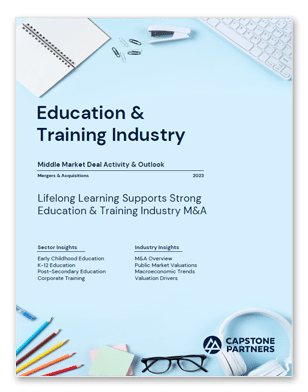Annual Education & Training M&A Report – Middle Market M&A Activity and Outlook
 Lifelong Learning Supports Strong Education & Training M&A
Lifelong Learning Supports Strong Education & Training M&A
Capstone Partners released its first annual Education & Training Industry M&A Activity & Outlook Report, offering insights and analysis into merger and acquisition (M&A) activity, public market valuations and drivers, and macroeconomic trends impacting the industry. The report also features several sector highlights and commentary on the rampant adoption of education technology (EdTech) sweeping across the industry.
Despite recent economic headwinds, the Education & Training industry is expected to be fairly protected from market volatility with heightened spending and federal funding through the CARES Act providing a favorable outlook for industry participants throughout 2023. Extending the lifetime value (LTV) of learners has been a key investment thesis adopted across the industry in 2022 and is expected to continue to drive revenue and acquisition opportunities for industry participants regardless of the economic conditions in 2023. Further industry consolidation is projected, as providers look to expand offerings and serve students from early childhood education through continuing professional education. Middle market participants that contribute to the LTV of learners will likely continue to be attractive acquisition targets in 2023.
Driven by heightened private equity interest, M&A activity in the Education & Training industry proved to be noncyclical in 2022. Although M&A volume declined year-over-year (YOY), 2021 was a record year as pent-up transaction demand from the pandemic drove deal flow to new heights, making for a difficult comparison. However, industry deal volume in 2022 outperformed 2020 and 2019 levels by 9.1% and 27.9%, respectively, demonstrating long-term growth despite current economic turmoil. Average Education & Training M&A purchase multiples also demonstrated resilience in 2022, outpacing the broader middle market average during the same period.
The Education & Training industry has become increasingly reliant on technology to facilitate learning and improve student outcomes. As a result, EdTech adoption swept across the industry in 2022 and is expected to yield considerable levels of M&A and financing activity in 2023. Of note, EdTech targets comprised 16.7% of industry M&A deals in 2022, marking a stark increase compared to pre-pandemic levels (4.1% in 2019).
Also included in this report:
- How the importance of digital literacy has driven demand in the Early Childhood Education sector.
- A breakdown of federal funding towards K-12 Education sector participants and how this is expected to support elevated spending levels in 2023.
- How vocational schools have withstood economic volatility, driving robust levels of buyer interest in the Post-Secondary Education sector.
- Why the M&A market has continued to favor Corporate Training sector players offering mandated continuing education services.
To discuss the trends included in the report, provide an update on your business, or learn more about Capstone’s wide range of advisory services and Education & Training industry knowledge, please contact us.
Related Transactions
Insights for Middle Market Leaders
Receive email updates with our proprietary data, reports, and insights as they’re published for the industries that matter to you most.








